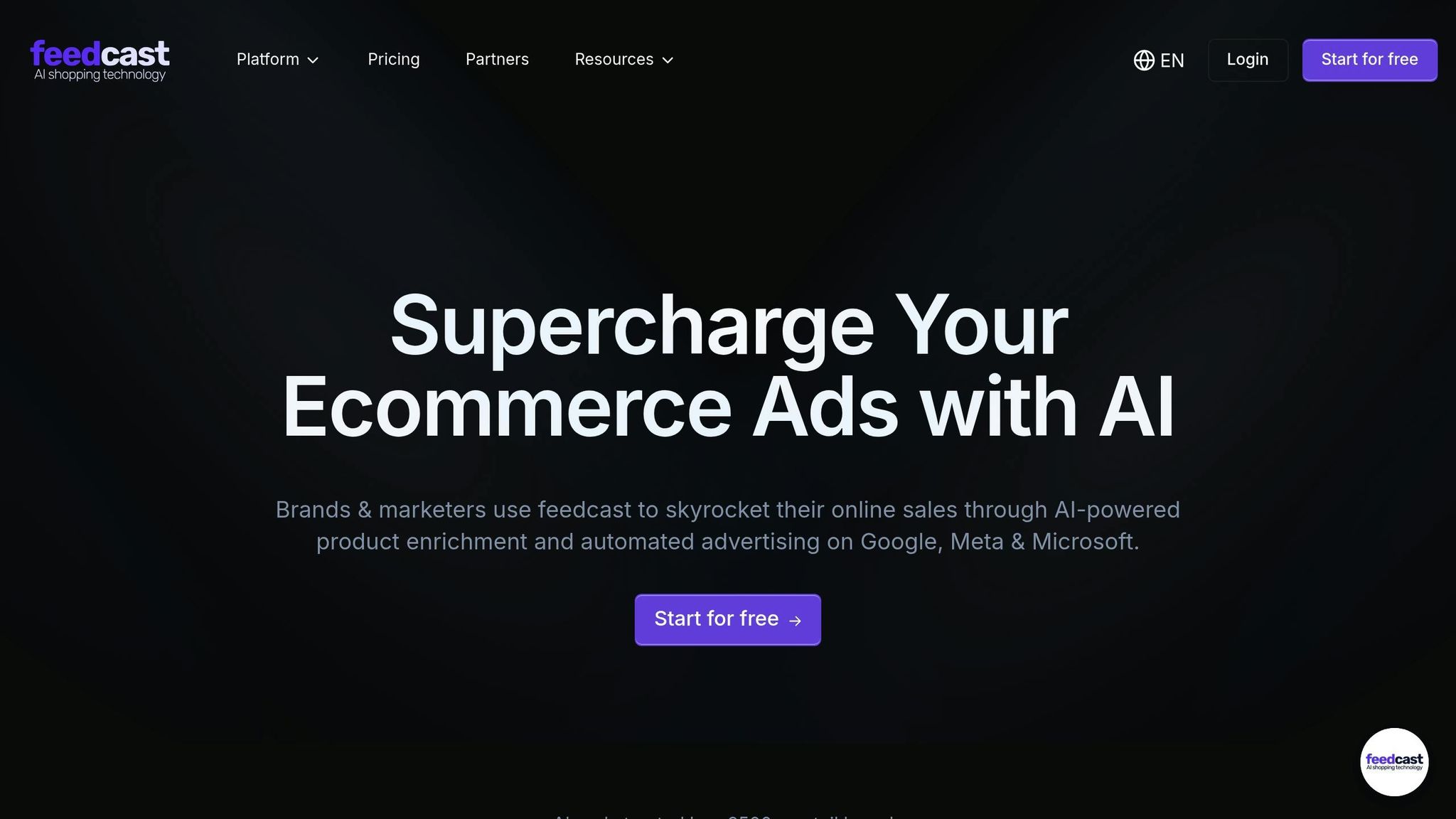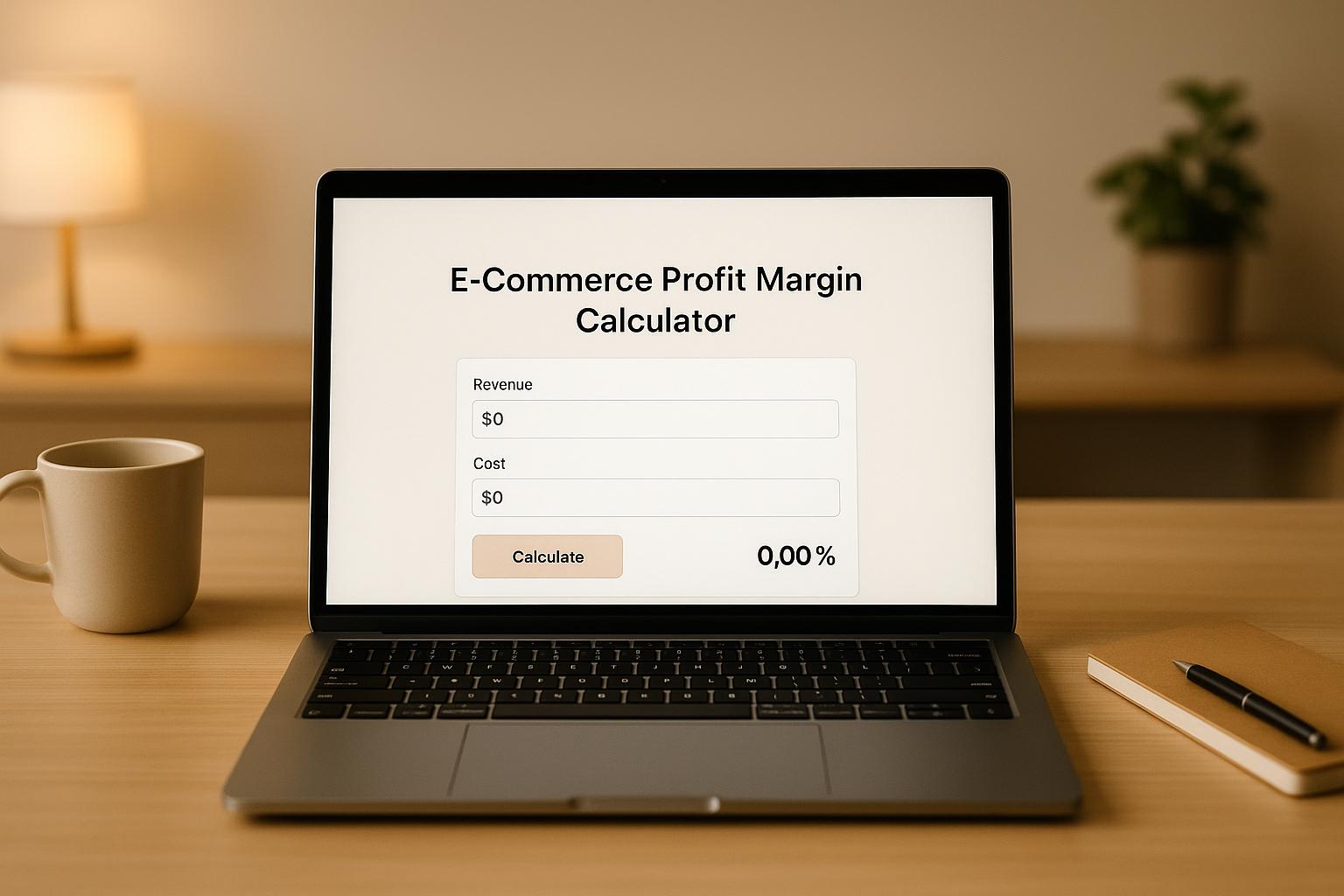Native Ad Metrics That Drive Product Sales
Native advertising works because it blends into content naturally, engaging users without being disruptive. But measuring its success requires more than just tracking clicks. To drive e-commerce sales effectively, focus on these key metrics:
- Click-Through Rate (CTR): Measures how often users click on your ads, signaling initial interest.
- Engagement Rate: Tracks actions like shares, comments, and time spent, showing deeper user interaction.
- Conversion Rate: The ultimate indicator of success - how many clicks turn into purchases.
- Cost Per Acquisition (CPA): Tells you how much it costs to gain a new customer and helps evaluate profitability.
- Bounce Rate: A high rate indicates a disconnect between the ad and landing page.
Tools like Feedcast.ai simplify tracking by consolidating data from multiple platforms into one dashboard, offering real-time insights to adjust campaigns quickly. By focusing on these metrics and refining strategies based on performance, you can optimize native ads to boost sales efficiently.
Why Native Ads Are the Secret Weapon of 8-Figure Brands
Key Native Ad Metrics That Drive Product Sales
Understanding the right metrics can make or break your native ad campaigns, especially when it comes to driving product sales. Let’s dive into the key indicators that directly influence e-commerce success.
Click-Through Rate (CTR) and Why It Matters
Click-through rate (CTR) measures how often users click on your native ads. It’s your first signal of user interest - essentially, the gateway to driving traffic to your product pages.
In content-heavy environments, CTR is crucial. A high CTR means your ad is grabbing attention and resonating with the audience. But it’s not just about clicks; it’s about attracting the right kind of clicks - those that lead to potential customers.
To boost CTR, your native ads need to blend seamlessly with the platform they’re on. Think about matching the tone, style, and visuals of the surrounding content while clearly showcasing your product’s value. The better your CTR, the more qualified traffic you’ll send to your site, which increases opportunities for sales.
Engagement Rate: Measuring Deeper Connections
Engagement rate goes beyond clicks to track how users interact with your content. This includes actions like comments, shares, saves, and even how long they spend viewing your ad or related content.
Why does this matter? Engagement reflects a deeper level of interest. For example, someone who shares your ad or engages with it for an extended period is more likely to buy than someone who just scrolls past. On social platforms, these interactions can also amplify your reach as others see and engage with shared content.
Since engagement can build over time, it’s important to monitor these metrics across the campaign’s duration. Strong engagement often translates into better sales conversions, as it signals that your message is resonating with potential buyers.
Conversion Rate: The Bottom Line
Conversion rate measures how many users take the desired action after interacting with your ad - whether it’s making a purchase, signing up for a newsletter, or adding items to their cart. For e-commerce, this is the metric that directly ties your native ads to sales.
While CTR and engagement show interest, conversion rate tells you how effectively your ads are turning that interest into revenue. Native advertising often works through a longer sales funnel, so it’s important to track conversions over time - 30, 60, or even 90 days - to get the full picture.
Interestingly, a campaign with a moderate CTR but a high conversion rate can outperform one with a higher CTR but fewer conversions. Ultimately, conversion rate is the clearest indicator of how well your ads are driving sales.
Cost Per Acquisition (CPA) and Profitability
Cost Per Acquisition (CPA) shows how much you’re spending to gain a new customer through your native ad campaigns. This metric is essential for understanding profitability and ensuring your campaigns are financially sustainable.
"Ultimately, a good CPA metric is one that is aligned with the business's objectives and delivers a positive return on investment over time." - Emotive [1]
CPA connects your ad spend to revenue. However, it’s not just about spending less - it’s about spending wisely. A lower CPA isn’t always better if it means attracting lower-quality customers who don’t convert or provide long-term value.
"Lower CPA improves your ROI (Return on Investment) by reducing the cost required to generate each conversion. A low CPA with high-quality leads ensures you're making more money than you're spending." - Anderson Collaborative [2]
Native ads may initially have a higher CPA due to the longer sales funnel, but these customers often have greater lifetime value. Balancing CPA with customer lifetime value ensures your campaigns are both effective and profitable in the long run.
Bounce Rate: A Warning Sign
Bounce rate measures the percentage of users who leave your site immediately after clicking on your native ad. Unlike other metrics, a high bounce rate is a red flag - it suggests something’s off with your ad targeting or landing page.
Native ads are designed to feel natural and provide value. If users click through but leave right away, it often means there’s a disconnect between the ad and the landing page. For e-commerce, this is especially problematic, as it indicates you’re attracting the wrong audience or failing to meet expectations.
To lower bounce rates, ensure your landing pages align perfectly with your ad’s messaging. Also, address any technical issues like slow load times or poor mobile optimization that could drive users away. A lower bounce rate means higher-quality traffic, which leads to better sales performance.
Research Insights: Metrics with the Strongest Connection to Sales
Recent studies have shed light on which metrics most directly influence product sales in native advertising. These findings can help e-commerce businesses zero in on the numbers that truly matter for driving revenue.
Key Findings from Industry Research
One of the standout conclusions is that conversion rate is the most reliable indicator of sales success in native advertising campaigns. While metrics like click-through rate (CTR) are often monitored, conversion rate stands out because it directly ties to sales performance, making it a stronger gauge of an ad's effectiveness.
Another important takeaway is the role of Cost Per Acquisition (CPA). Keeping CPA at favorable levels has been shown to boost overall campaign outcomes. Meanwhile, engagement rate emerges as a useful early signal for predicting future sales, especially in campaigns targeting repeat customers.
The research also highlights the importance of time-to-conversion. Unlike traditional display ads, native advertising often sees conversions happen over longer periods after the initial interaction. This underscores the need for a broader evaluation window when measuring campaign success.
Comparison of Metrics' Impact on Sales
Looking deeper into the data, it becomes clear that not all metrics are equally tied to sales. For instance, a high click-through rate might suggest good ad placement, but it doesn’t always lead to actual purchases. On the other hand, bounce rate - the percentage of users who leave a page without further interaction - can serve as an inverse indicator of success. Lower bounce rates often align with higher conversion rates.
Another key metric is Return on Ad Spend (ROAS). This is a vital measure for e-commerce campaigns, particularly because native advertising often has a longer conversion cycle. Evaluating ROAS over time provides a better picture of how these campaigns ultimately contribute to sales.
Increasingly, cross-device tracking is proving essential. By following customer interactions across multiple devices, businesses can get a clearer sense of how native ads influence the entire buyer journey, from initial engagement to final purchase.
Areas of Agreement and Debate Among Experts
These findings underline the importance of leveraging data-driven strategies in native advertising. Most experts agree that optimizing conversion rates should be a top priority for e-commerce campaigns. However, there’s ongoing debate about the ideal attribution window. Some argue for shorter windows to capture immediate intent, while others advocate for longer periods to account for delayed conversions.
Viewability metrics remain a contentious topic. Researchers are still debating the thresholds and exposure times needed for native ads to be effective, leaving room for further study in this area.
Opinions also differ on the role of brand lift metrics. While some see them as secondary to direct sales indicators, others argue that improving brand awareness can drive long-term sales growth.
Another hot topic is the choice between multi-touch and last-click attribution models. Many experts lean toward multi-touch models, which capture the full influence of native ads across various channels. However, simpler models like last-click attribution remain popular due to their ease of use. Advances in real-time and cross-device analytics are helping refine these attribution approaches.
Finally, the shift away from third-party cookies has made privacy-compliant methods more critical than ever. As businesses adapt, first-party data is expected to play a central role in accurately measuring the success of native advertising campaigns.
sbb-itb-0bd1697
Optimizing Native Ad Campaigns Using Advanced Analytics
Research shows that advanced analytics can transform native ad metrics into actual sales growth. By moving beyond basic performance tracking, these sophisticated tools enable e-commerce businesses to connect the dots between native ads and revenue, offering a clearer picture of their impact.
Cross-Channel Performance Tracking
Native advertising campaigns don’t exist in a vacuum - they thrive when integrated with other marketing channels. Cross-channel performance tracking provides a holistic view by pulling data from multiple platforms, revealing how native ads contribute to the entire customer experience.
This approach maps out complete customer journeys, from the first interaction to the final purchase. For example, a customer might discover your product through a native ad on a content site, visit your website directly days later, and finally complete their purchase after seeing a retargeting ad on social media. Without cross-channel tracking, these connections might go unnoticed, leading you to underestimate the native ad’s role in the sale.
By linking customer interactions across various touchpoints - native ads, search ads, email campaigns, social media, and direct website visits - you gain a clearer understanding of how each channel influences conversions. Attribution modeling becomes essential here, helping you allocate your marketing budget effectively by identifying which channels drive results.
Cross-channel insights also allow you to fine-tune the timing and sequence of your campaigns. You might discover that native ads are most effective at raising awareness early in the customer journey, while other formats work better for closing sales. Armed with this knowledge, you can structure your campaigns more strategically and make dynamic, real-time adjustments to maximize impact.
Real-Time Analytics for Campaign Adjustments
Real-time analytics take campaign management to the next level, enabling you to respond to issues and opportunities as they arise. With real-time analytics, you don’t have to wait days or weeks to identify what’s working - or what isn’t.
This quick feedback loop is especially valuable for native ads, which often have longer conversion cycles. For instance, if engagement is high but conversions are lagging, you can immediately test changes to your landing page or adjust your budget allocation. Real-time data empowers you to act fast, testing and refining strategies in hours rather than days.
Budget optimization also becomes more precise. If certain audience segments or placements perform better at specific times, you can shift your budget on the spot to capitalize on these trends. This prevents wasted spending on underperforming areas while ensuring high-performing segments get the attention they deserve.
Real-time analytics are equally powerful when it comes to creative testing and optimization. By quickly identifying which ad variations resonate with your audience, you can pause underperforming creatives and focus on what works. This rapid iteration cycle improves overall campaign performance and boosts your return on ad spend.
How Feedcast.ai Facilitates Unified Analytics

Feedcast.ai takes advanced analytics and real-time insights a step further by simplifying campaign management. Instead of juggling multiple dashboards, Feedcast.ai consolidates all your data into a single, unified view.
This streamlined approach makes cross-channel analysis much easier. You can directly compare how your native ads perform across different platforms and how they contribute to your overall sales goals. With real-time metrics, you can monitor performance and make adjustments without constantly switching between interfaces.
The platform’s custom reporting options let you focus on the metrics that matter most, whether it’s conversion rates, cost per acquisition, or return on ad spend. These tailored reports provide a clear picture of how your campaigns are performing across all channels.
Feedcast.ai also integrates AI-powered optimization tools that offer actionable recommendations based on your performance data. This combination of detailed tracking and intelligent suggestions ensures your campaigns are always improving, rather than stagnating with outdated settings.
For e-commerce businesses running native ads as part of a larger marketing strategy, Feedcast.ai’s unified analytics eliminate the hassle of managing multiple data sources. It provides the insights you need to refine your campaigns and drive more sales, all while simplifying the process.
Best Practices for Using Metrics to Boost Sales
Turning native ad metrics into sales isn’t just about gathering data - it’s about using that data effectively. The most successful e-commerce businesses know how to translate numbers into meaningful insights, driving better campaign performance and, ultimately, higher sales.
Setting Clear Goals for Campaigns
To make the most of native ad metrics, start by defining specific, measurable goals. Without clear objectives, it’s tough to pinpoint the right metrics or evaluate their impact on sales.
First, identify your campaign’s primary focus - whether it’s brand awareness, lead generation, or direct sales. Each goal requires a different approach. For example:
- Brand awareness campaigns prioritize metrics like engagement rate and reach.
- Direct sales campaigns focus on conversion rates and cost per acquisition (CPA).
Once you’ve set your focus, aim for precise targets. Instead of vaguely aiming to "boost click-through rates", set a goal like increasing your CTR from 0.8% to 1.2% within 30 days. Specific benchmarks make it easier to track progress and adjust strategies when needed.
Also, factor in your customer lifetime value (CLV). If a typical customer brings in $200 over six months, you might accept a higher CPA for native ads that attract quality leads, even if those ads don’t convert as quickly as others.
Lastly, allow enough time for evaluation. Native ads often require longer conversion cycles, so consider reviewing performance over 2–4 weeks instead of weekly, as you might with search ads.
Using Metric Insights for Targeting and Content
Native ad metrics can reveal what resonates with your audience and what doesn’t. By analyzing these insights, you can fine-tune both your targeting and your content.
- Click-through rate (CTR): High CTRs from specific demographics show which audiences connect with your ads. Expand targeting to similar groups. Conversely, low CTRs could mean your content isn’t hitting the mark or doesn’t fit the platform’s context.
- Engagement metrics: High engagement paired with low conversions often signals a disconnect. Maybe your call-to-action isn’t strong enough, or your landing page doesn’t align with the ad’s message.
- Bounce rate: If certain traffic sources or audience segments have high bounce rates, it’s a sign of poor alignment. Shift focus to audiences who engage more meaningfully.
- Timing patterns: Metrics showing peak performance times - specific hours or days - help you adjust your budget to maximize results during those windows.
- Top-performing ads: Look for patterns in your best-performing creatives. Are there recurring themes in headlines, visuals, or calls-to-action? Use these insights to guide future content creation.
Continuous Testing and Refinement
Even with strong targeting and solid content, you’ll need ongoing testing to keep improving. Native ad campaigns thrive on adaptability, with continuous tweaks ensuring they stay relevant to audience preferences and market trends.
- A/B testing: Regularly test one element at a time - like headlines, images, or calls-to-action - to see what drives better results. Since native ads often have longer conversion cycles, tests should run for at least 2–3 weeks to gather reliable data.
- Creative rotation: Prevent ad fatigue by refreshing visuals and messages when engagement starts to dip. Keep a close eye on performance metrics to know when it’s time for a change.
- Audience refinement: Use performance data to identify high-converting, low-CPA segments. Shift your budget toward these groups while experimenting with new audience variations.
- Landing page optimization: If your ads get clicks but fail to convert, the issue might be your landing page. Test different layouts, messaging, and calls-to-action to improve the post-click experience.
- Budget reallocation: Regularly analyze performance trends to decide where to invest more or scale back. Tools like Feedcast.ai simplify this process by consolidating all your metrics into one dashboard, making it easier to spot high-performing campaigns.
Document your results and learn from them. Tracking improvements over time gives you a playbook for future campaigns, helping you make faster, smarter decisions.
Conclusion: Key Takeaways on Native Ad Metrics
Focusing on the right metrics and using them wisely can turn native advertising into a powerful tool for driving e-commerce sales, rather than a drain on your budget.
Recap of Key Metrics
Certain metrics stand out as essential for measuring the success of native ads. Click-through rate (CTR) shows whether your audience is intrigued enough to engage. Conversion rate takes that interest a step further, showing how many of those clicks turn into actual sales. And return on investment (ROI) tells you whether the financial results justify the effort. When looking at cost per acquisition (CPA), it’s important to focus on acquiring customers who bring long-term value, not just aiming for the lowest cost. Engagement metrics like time spent on the page can reveal how well your content connects with your audience, while a high bounce rate often signals a mismatch between your ad and landing page.
The Importance of Constant Refinement
Native advertising isn’t a "set it and forget it" strategy. It requires ongoing tweaks based on performance data. As market trends, audience behaviors, and platform algorithms shift, even small changes - like reworking a headline or fine-tuning your targeting - can lead to noticeable improvements. These performance insights help businesses stay agile and make smarter campaign decisions.
Simplifying Metrics Management with Feedcast
For e-commerce businesses juggling multiple campaigns, tools like Feedcast.ai can make managing native ad metrics much easier. By consolidating performance data from various platforms into a single, real-time dashboard, Feedcast enables quick adjustments on the fly. Its cross-channel tracking offers a complete picture of how native ads fit into your broader marketing strategy, making it easier to allocate your budget efficiently without adding unnecessary complexity.
FAQs
What native ad metrics should I focus on to boost e-commerce sales?
To drive e-commerce sales through native advertising, focus on the numbers that truly matter. Metrics like click-through rate (CTR), conversion rate, and return on ad spend (ROAS) are essential for gauging how well your ads are turning clicks into sales. These figures reveal how engaged your audience is and whether your campaigns are profitable.
It’s also worth keeping an eye on engagement stats such as time on page and scroll depth. These can show how well your content is connecting with users. Regularly reviewing these insights allows you to fine-tune your targeting, enhance your ad designs, and direct your budget toward campaigns that are delivering results. This approach helps ensure your advertising efforts translate into stronger sales and a solid return on your investment.
What are the key mistakes to avoid when analyzing native ad metrics like CTR and CPA?
When looking at metrics like CTR (Click-Through Rate) and CPA (Cost Per Acquisition) for native ads, it's easy to fall into a few common traps that can skew your analysis. One frequent misstep is putting too much weight on CTR as a success indicator. Sure, a high CTR might suggest that your ad is grabbing attention, but it doesn’t necessarily mean it’s driving conversions or sales - the outcomes that usually matter most.
Another pitfall is zeroing in on CPA without considering the quality of the traffic or user engagement. A low CPA might seem like a win, but if the traffic it brings is irrelevant or unengaged, it’s unlikely to lead to meaningful results. For a clearer picture, it’s essential to look at multiple metrics together and evaluate them in the context of your campaign’s overall goals. Balancing these insights can help you make smarter decisions.
How does tracking performance across channels improve native ad campaigns?
Tracking how campaigns perform across different channels gives marketers a holistic view of customer interactions. This big-picture perspective makes it easier to pinpoint which strategies are effective and where tweaks might be necessary, keeping campaigns in sync with audience behavior.
Real-time performance analysis allows marketers to fine-tune targeting, messaging, and ad placements on the fly. The result? Better engagement, a smoother customer experience, and more efficient use of resources, ensuring efforts are directed where they’ll make the biggest difference.
Yohann B.




